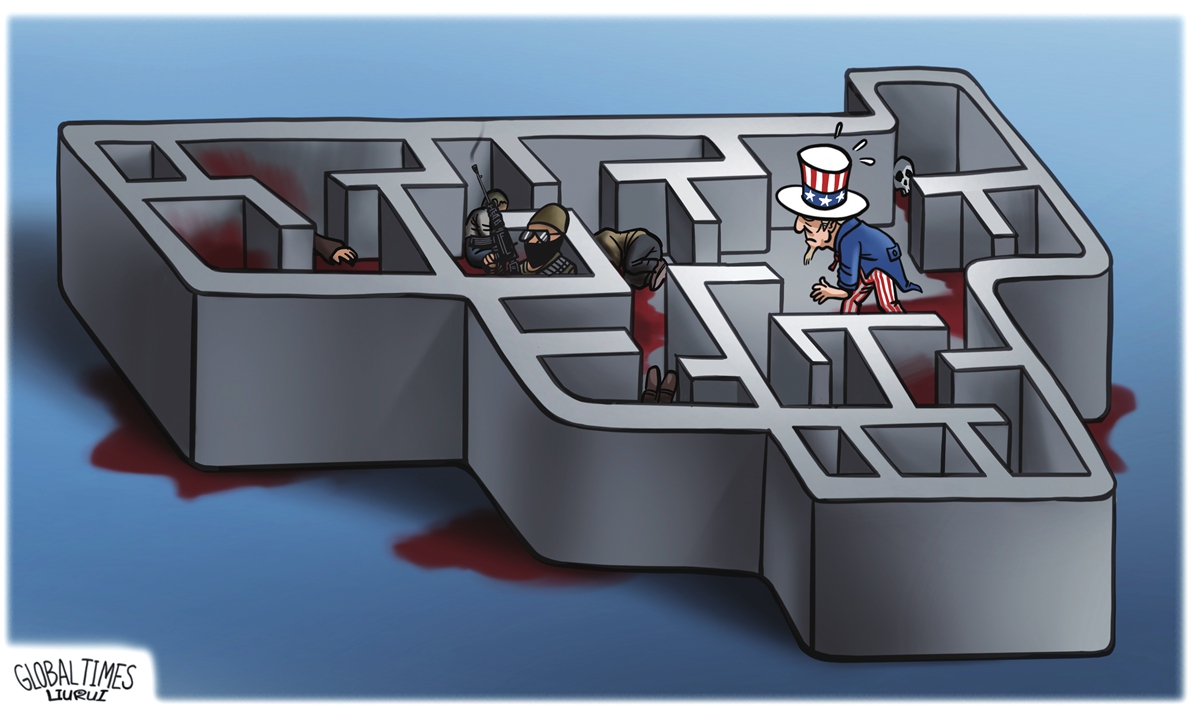Gun Violence in the United States : Facts

Introduction
Gun violence has become a chronic disease in the United States. Due to intricate interplay of gun culture with individual rights, interest groups and partisan politics, it has now come to haunt the American society like a plague. It has gravely violated people’s right to life, leaving an indelible stain on the country’s human rights record.
The above facts and figures, shed light on the alarming state of gun violence in the United States and the political and social causes of this entrenched problem.
I. The Surge of Gun Violence in the United States
Gun violence has become the acutest social problems in the United States, with ramifications not only for the victims and their families, but also for the entire society and country. In addition to the casualties caused and the threat to public security, it has also resulted in enormous economic losses and social trauma for the nation.Even the International community feels highly alarmed
◆ The United States is the country with the most civilian-held firearms. With less than 5 percent of the world’s population, it accounts for 46 percent of global civilian gun ownership. As estimated by the Small Arms Survey in Switzerland, the global stockpile of civilian-held firearms has increased from 650 million in 2006 to 857 million in 2017, largely attributable to soaring figures in the United States. In 2017, about 393.3 million guns were privately owned in the United States at a time when its population was less than 326.5 million. This amounts to 120.5 firearms for every 100 people. The second-ranked country was war-torn Yemen, with 52.8 guns per 100 people. While the United States ranks first in the world in terms of both individual gun ownership and the number of guns per capita, only about 1.07 million civilian guns are registered, indicating that the vast majority of firearms owned by civilians are left unregistered and uncounted.
◆A latest study by the Bureau of Alcohol, Tobacco, Firearms and Explosives (ATF) reveals that the United States is in the midst of a massive gun-buying boom that shows no signs of abating. From 2000 to 2020, annual production of firearms in the country almost tripled, with a dramatic increase in the past three years in particular. Since 2020, the COVID-19 pandemic has brought about more social problems. The “Black Lives Matter (BLM)” movement sparked a series of looting and riots, aggravating social insecurity. As a result, demand for semi-automatic pistols for self-protection surged and gun sales soared at a record pace. According to the US National Shooting Sports Foundation (NSSF), the United States conducted 21 million background checks for gun purchases in 2020, a 60 percent increase from 2019 and a record high, surpassing the previous record in 2016 by 5.3 million. The sudden first-time gun ownership by millions of Americans has inevitably given rise to considerable security threats.
◆Individual ownership of a large number of guns has triggered incessant violence, putting social security in the United States at greater risk. As pointed out by some American scholars, gun-related deaths in the United States in one week may exceed those in the whole Western Europe in one year. Amid the COVID-19 pandemic, the firearm homicide rate in the United States reached its highest level since 1994. According to a survey by the Giffords Law Center, 32 of the country’s 50 largest cities witnessed a prominent increase in firearm homicides in 2021. The Guardian reported in October 2021 that every 16 hours, a woman is fatally shot by her partner in the United States. According to data from the US Centers for Disease Control and Prevention (CDC), from 2018 to 2021, the proliferation of guns not only resulted in a spike in homicides across the country, but also led to more suicides by people with mental illnesses. According to the Gun Violence Archive (GVA), gun-related casualties surged to 85,584 in 2021 from 34,231 in 2014. Among the nearly 95,000 homicides between 2015 and 2019, about 74 percent were committed with firearms. In 2020, firearm-related deaths reached 45,222, an average of 124 per day. Firearm injuries are one of the top five causes of death for people aged 1 to 44 in the country.
◆Recent years have witnessed frequent mass shootings in the United States, causing alarmingly high casualties. By American standards, a mass shooting is defined as an incident of gun violence in which four or more people are injured or killed, excluding the suspect or the gunman. According to GVA data, both mass shootings and deaths in the United States have surged about fourfold since 2013. There were 417 mass shootings in the country in 2019, 611 in 2020, and 692 in 2021. In 2022, there were 213 mass shootings reported in 34 states and the capital Washington, D.C. by the end of May, with 242 killed and 912 wounded, a 50 percent increase over the same period in 2017 and a 150 percent increase over the same period in 2013. On July 4, 2022, Independence Day of the United States, a 21-year-old white man fired more than 50 shots from a rooftop at a parade in Highland Park, a suburb north of Chicago, killing at least seven people and injuring more than 30. On Jan. 21 and 23, 2023, tragic shootings occurred in Monterey Park of Los Angeles County, California and Half Moon Bay in northern California, killing 17 and injuring 11.
◆The United States has seen repeated mass school shootings for many years, causing serious trauma to the American society. The mass shooting at the Columbine High School in Colorado in April 1999 killed 13 people and left more than 20 injured. In April 2007, the shooting at Virginia Tech resulted in the death of 32 students and faculty members. GVA data show that, over the past decade, 27 mass school shootings took place in the United States. The deadliest shootings among them are: December 2012, Connecticut, Sandy Hook Elementary School shooting, 26 killed including 20 children aged six to seven; October 2015, Roseburg, Oregon, Umpqua Community College shooting, 10 killed; February 2018, Parkland, Florida, Marjory Stoneman Douglas High School shooting, 17 killed (14 students and 3 faculty members) and 17 injured; May 2018, Houston, Santa Fe High School shooting, 10 killed. In May 2022, an 18-year-old gunman entered the Robb Elementary School in Uvalde, Texas, and killed 21 people including 19 children. This last incident was the 27th school shooting in the United States in 2022. It was also one of the worst in recent years.
◆Gun violence also inflicts huge economic losses. According to Brady, an organization that advocates gun control, gun violence costs the US economy at least 229 billion US dollars each year. In May 2022, in the wake of the shooting at the Robb Elementary School in Uvalde County, Texas, over 200 CEOs co-signed a letter urging the US Senate to take immediate actions to address gun violence. In the letter, it was stated that “gun violence costs American taxpayers, employers and communities a staggering 280 billion US dollars per year”.
◆Gun violence has also taken a toll on the everyday life of the American people. A poll conducted by the University of Chicago Harris School of Public Policy and the Associated Press-NORC Center for Public Affairs Research found that 21 percent of American adults have experienced gun violence in which their relatives, friends or themselves have been threatened with a gun or have fallen victim to a shooting. As many as 54 percent of black and hispanic Americans say that they have had similar experience. The Associated Press reported a survey by the American Psychological Association (APA), which shows that one-third of American adults feel they cannot go anywhere without worrying about being a victim of a mass shooting, and nearly a quarter of them admit that they have changed their behavior due to fear of mass shootings.
II.Gun Control: An Uphill Battle in the United States
Since the end of the 19th century, US state and local governments have made various attempts to introduce legislation on gun control, but such efforts all ended up either long in words but short on action, or flip-flopped. No real progress was made on gun control.
◆The second amendment to the US Constitution provides for the right of individuals to keep and bear arms. In recent years, as gun-related issues have become increasingly prominent, pro-gun and pro-control advocates have engaged in heated debates on the interpretation of the second amendment. Organizations that support gun rights claim that individual rights should not be arbitrarily modified and gun control is illegal. Organizations that support gun control argue that the second amendment establishes a collective right, rather than an individual right to possess guns, and the government has the right to control guns. Such debates have resulted in stalled efforts on gun control legislation, and Supreme Court rulings based on the second amendment are often not in favor of gun control.
◆In the United States, there is significant disparity in gun control from state to state, and relevant legislation efforts at the federal level are often slow, inconsistent and contradictory. In 1927, an act passed by Congress banned mail shipment of firearms such as pistols and revolvers to individuals, but did not prohibit the delivery of such firearms through private delivery firms. Under this act, individuals are allowed to buy guns across state lines. In 1968, the Gun Control Act passed by Congress did not include registration and licensing requirements for all firearms and their carriers, nor did it ban the import of firearm components. In 1969, the lobbying power of the US National Rifle Association (NRA) propelled Congress to waive requirement for registration of buyers’ information by sellers of shotgun and rifle cartridges. In 1986, the Firearms Owners’ Protection Act signed by President Ronald Reagan made it easier for unlicensed individuals to sell firearms. It also allowed firearms to be sold at gun shows, and banned the establishment of any comprehensive system of firearm registration.
◆In 2005, Congress passed the Protection of Lawful Commerce in Arms Act, which protects firearm manufacturers from civil liability for crimes committed with their products. Pro-gun groups have also used legislation and federal courts to resist gun control efforts. In June 2008, the US Supreme Court ruled 5-4 in the case of District of Columbia v. Heller. With this ruling, the District of Columbia lifted the ban on handguns and allowed individuals to keep guns at home. Justice Antonin Scalia, who presided over the case, noted that the second amendment protects an individual’s right to keep and bear firearms, and that the District of Columbia’s ban on handgun possession in the home violated that right. The Supreme Court’s ruling and its opinion on this case have directly affected gun control legislation across the United States. In 2012, in the wake of a mass shooting at Sandy Hook Elementary school, Senators Joe Manchin and Patrick Toomey drafted a compromise bill to expand background checks on gun buyers. The bill fell short of the 60 votes required to move forward and was thus defeated. In the ensuing decade, all congressional efforts to pass bills to enhance background checks on gun buyers ended up in failure.
◆In March 2021, the House passed the “Bipartisan Background Checks Act of 2021”, which requires background checks on all gun sales. In May 2022, two mass shootings in Buffalo, New York and Uvalde, Texas sparked hundreds of anti-gun violence demonstrations, and calls for gun control re-surged. The Senate and the House adopted new gun control legislation, only after Democrats significantly weakened the control measures. At the same time, however, the Supreme Court issued a ruling striking down New York State’s 1911 law which restricts carrying a concealed firearm in public. This directly undermined the ability of state and local governments to monitor firearms in New York, California, Hawaii, Maryland, Massachusetts and New Jersey, among others.
◆Due to the difficulty of Congress to act on gun control, the US administration could only regulate certain types of firearms and firearm modifications through presidential executive orders. In June 2022, Congress passed a gun-related bill called the Bipartisan Safer Communities Act. According to a Pew poll, most people are not optimistic about the bill’s effect in reducing gun violence in the United States. Seventy-eight percent think it will do little, of which 36 percent think it will do nothing at all.
◆The American public is deeply divided on gun control. Public opinion polls in recent years have shown that women, urban residents, non-native borns, liberal-leaning people and non-gun owners are more likely to support gun control, while men, rural residents, native-born Americans, political conservatives, hunters and gun owners oppose it. The gap between Americans’ stance on gun control is still widening.
III.Gun Violence Lays Bare the Decline of US Governance Capacity
Given a political system where different sides hold each other back, an increasingly polarized political ecosystem, pervasive interest groups and ineradicable racial discrimination, gun control in the United States is in stalemate, and a total ban on guns is effectively a mission impossible.
◆How the US political system is designed and operates constitutes the root cause of ineffective gun control. Gun control intensity varies across different states, making it increasingly difficult to regulate guns and perform interstate enforcement. Everytown for Gun Safety, a gun control group, compared gun policies across the country, rating every state on the strength of its gun laws and comparing it with its gun violence occurrence. A positive correlation was found between ineffective gun control and gun violence rate. Eight states, including California and Hawaii, with comparatively well-established gun laws saw relatively low gun violence rates, while the 13 states with the weakest gun control, including Texas, Alaska and Missouri, have nearly three times as many gun deaths as the eight states mentioned above.
◆Positions of Democrats and Republicans on gun control are becoming increasingly polarized. In 1968, the House voted 305-118 and the Senate 70-17 to pass the Gun Control Act. Since then, the two parties have been increasingly divergent over gun control. Republicans have always supported gun ownership, while Democrats have unequivocally supported gun control. Given the polarized US political landscape at present, it is even more difficult for either party to compromise. The New York Times reported that since the mass shooting at Sandy Hook, despite a Democratic push for gun control, 14 Republican-controlled states have gone the opposite way, passing laws allowing their citizens to carry guns without any licensing process. The Washington Post reported that in recent years, the Republican Party has posted a myriad of pictures and videos containing guns in newspapers, billboards and social media to appeal to voters who oppose gun control for campaigning purposes.
◆Interest group lobbying is rampant. Group politics and electoral politics in the United States have provided legalized channels for gun groups to conduct money politics and influence the stance of Congress members on guns. According to OpenSecrets statistics, from 1990 to 2022, gun ownership groups contributed 69.3 million US dollars to federal and state candidates, while gun control groups contributed 51.6 million US dollars. From 1998 to 2022, gun ownership groups spent 190.4 million US dollars on lobbying, while gun control groups spent 28.9 million US dollars. In the 117th Congress, 262 members have been sponsored by the NRA, among which 19 have each received more than 1 million US dollars cumulatively. The vast majority of them are Republicans. Meanwhile, the NRA has spent handsomely against pro-gun control lawmakers. All five of the lawmakers whom the association has paid millions of dollars to oppose are Democrats.
◆Gun violence is exacerbated by long-standing social problems in the United States such as social inequality and racial tensions. Research shows that blacks are much more likely to encounter gun murder than whites, and half of all gun murder victims are black. In 2010, 14.6 out of 100,000 blacks were murdered, compared with 1.9 for whites. According to research by the CDC, between 2019 and 2020, gun homicides nationwide rose from 14,392 to 19,350, with the occurrence rate up from 4.6 to 6.1 per 100,000 people, a 34.6 percent increase. Of the 90,498 gun-related deaths in 2020 and 2021, 38,796 were murders, among which nearly 21,000 involved young black males.
Conclusion
The right to life is the biggest human right. The Declaration of Independence begins with the statement that life, liberty and the pursuit of happiness are unalienable rights. One gunshot after another have shattered the American Dream that all men are endowed with the unalienable rights to life and liberty, and lead people to reflect deeply on where the American-style human rights really are. Some US politicians have long treated the American people’s right to life with indifference. Faced with growing gun proliferation, they have done nothing more than empty talks and prolonged debates, while pointing fingers at the human rights conditions of other countries. The most important thing that they are duty-bound to do is face up to and address their own problems, and let the American people enjoy true freedom from the fear of gun violence.




